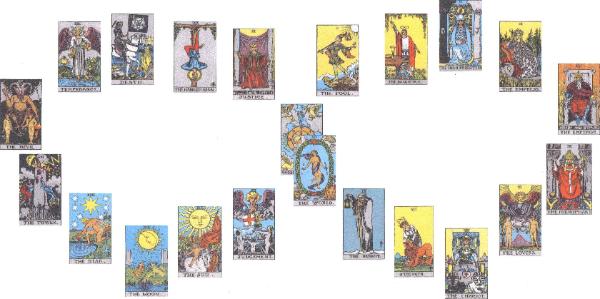The Lemniscate Tableau

The Lemniscate is an important geometrical figure in Tarot. It is also the sign of Infinity, it connects us to the spirals of creation, to the whirling motions of the Tree of Life. The sign is displayed above the heads of the Magician and Strength in the Waite Smith deck, as well as in the garland surrounding the World Dancer of Key XXI. We will also find this sign in the Two of Pentacles, which was considered the "key" card of the Minors and usually carried the signature or emblem of the printer of the deck or the card maker. In Alchemy, this symbol was usually intimated with two snakes biting their tail, for example, or two circles with the images of the Sun and the Moon making the figure 8.
Barbara G. Walker (The Secrets of the Tarot: Origins, History, and Symbolism, 1984) gives us a version of this tableau when she speaks of the Wheels of Becoming. She notes that the infinity sign implies a hierosgamos, the sacred marriage of male and female energies, of matter and spirit; of conscious and unconscious energies. The tableau is supposed to be laid out with the Emperor and the Hierophant on the top and the Tower and the Devil on the bottom; one circle is the solar and the other is the lunar circle; the solar faces outward (the material world) while the lunar faces inward, toward the spiritual realm. This configuration is still used in some rituals, especially using the Marseilles deck. I am presenting this particular pattern because this is the one that I use. with all cards facing the reader in a horizontal position. The Wheel of Fortune and the World cross at the center; and this is, in reality, the key to this
tableau. As I have noted somewhere else, the Wheel of Fortune as illustrated by the Waite Smith deck and the Rosicrucian tradition, was supposed to represent a "lesser"aspect of the World, and therefore we have the same fixed Zodiac signs illustrating the four corners or directions in both cards.
Notice all the correspondences, and the energies that flow from one card to the other when we use this formation. In Dr. Walker's diagram the cards are supposed to be paired with their opposites adding up to 20 (the finger-and-toes number sacred in both the Mayan and the Indo-European traditions), and if we use this particular scheme, we find quite interesting correlations; between such keys as 1 and 19; 2 and 18; 3 ad 17, etc, etc. Go ahead and meditate on these combinations and then, why not ponder the correlations between the keys that add to 21, like the Fool with the World; or the Devil and the Lovers? The Pythagoreans considered numbers sacred and there is much richness and wisdom when we allow these numerical combinations to play on their own and open for us new doors of interpretation for these magical images.
Note: See also Irene Gad, Tarot and Individuation: A Jungian Study of Correspondences with Cabala, Alchemy, and the Chakras, p. 415. The Lemniscate diagram also appears on the frontispiece of Alfred Douglas' The Tarot, as illustrated by David Sheridan, 1972.
Copyright © 2010 YMRobinson